
Standing out from the competition in the roofing business means using all the roofing marketing ideas at your disposal. From social media to content marketing, roofers have to try every digital tactic possible to attract more customers.
Blogging may not sound like a roofer’s first choice, but it should be. Blogging is one of the best, most consistent, inbound lead generation tactics for roofers.
If you need help starting a blog for your site, or getting your current blog to perform well on search engines, you’re in the right place. In this article, we’ll go over everything you need to know about choosing roofing blog topics to attract more customers.
Why is blogging important for roofing companies?
Just imagine, when a potential customer has a hail damaged roof, where are they going to turn for information on how to fix the damage?
Most likely, they’ll go online and look up something like ‘hail damage roof repair’ into Google. With a quality blog, your article on ‘how to repair your roof’s hail damage’ could come up and lead them right to your roofing services.
That’s what makes blogging one of the most effective modern lead generation tactics. And if you hire the right SEO company, it requires little to no effort from you. Plus, each blog can bring in new clients for years after publication. It’s that type of lasting value that has 86% of all US companies producing blog content in 2020.
5 roofing blog topics
So we know blogging is important, but what does a roofing company blog look like? Well, there are a few general blog topics all roofers should have on their blog, but after that, you’ll need to use keyword research tools to find trending and relevant ideas.
More on that later, but for now, here are five blog topics to get you started on your roofing blog:
FAQs
Frequently asked questions, or FAQs, are some of the best performing pieces of blog content for roofers. Not only do they naturally draw in a lot of organic traffic, but they are also the ideal conversion tool.
FAQ blogs can turn visitors into clients, and with a high-value service like roofing, it doesn’t take many sales to make up the costs of creating a blog.
On top of that, FAQ blogs will allow your business to be featured on Google in what are called featured snippets. Featured snippets are concise, quality answers for commonly asked questions that appear in prominent positions on Google’s results pages.
Here’s an example featured snippet blog win from Andrews Roofing, answering the question, “should I worry about frost on my roof?”
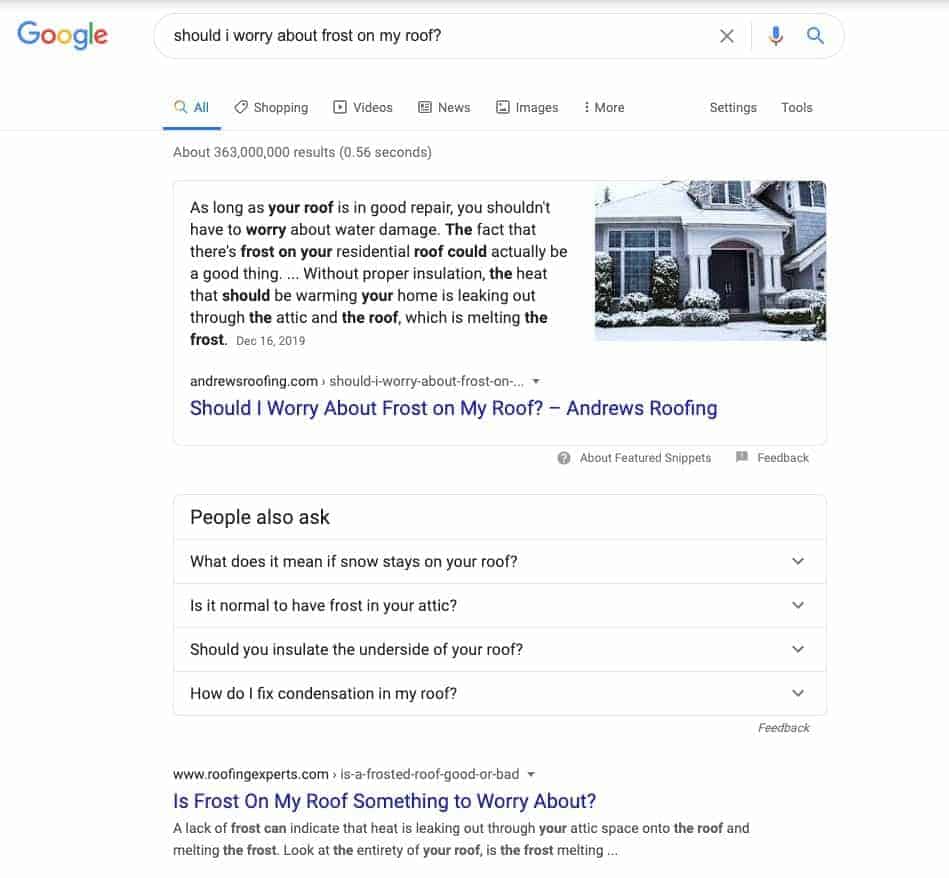
The snippet is featured above organic results, and the People Also Ask section (more on this later) as well, and it leads back to the Andrews’ blog post on the topic.
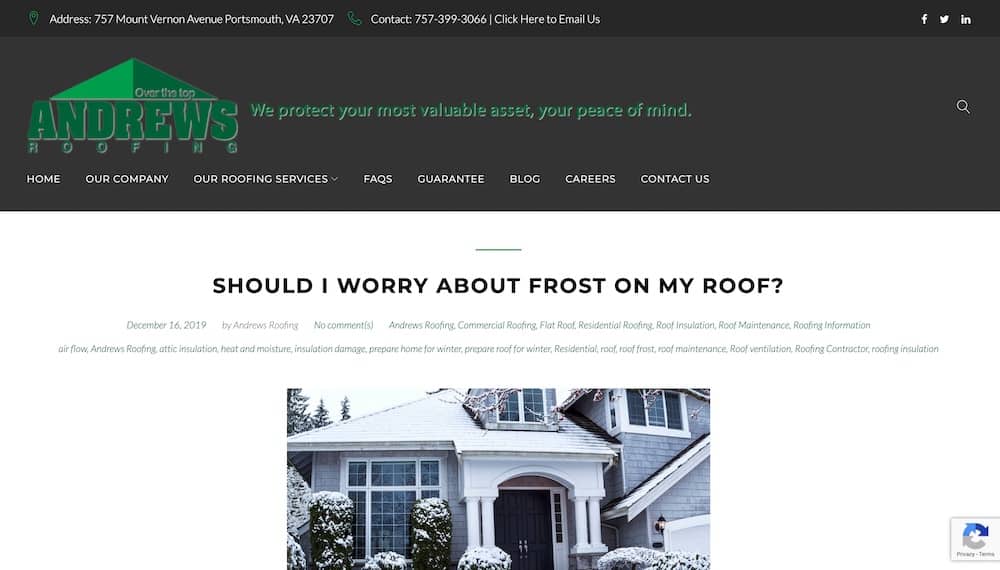
You can see how getting featured in spots like these is excellent for business. When you’re at home relaxing, your blog is out there working to bring in new leads for your roofing business like an automated salesperson.
Area of specialty
Creating roofing blog topics that go into detail about your particular areas of specialty is extremely important for search engine optimization. By adding specific services and creating content about them, your website’s relevance for important keywords in search engines will increase. That means more organic traffic is looking for your services.
For example, not all roofers do commercial roofing. If you do, creating a blog about your services can have two benefits 1) it will show potential customers you’re an industry expert. And 2) for search engines, the more content you create about specific, niche services, the more easily you will rank for relating keywords on Google’s results.
Here’s an example of an ‘area of specialty’ blog from The Roofing Company out of Granby, CO.

Tips and Tricks
Quick tips and tricks blogs are ideal for drawing in customers who maintain their roofs regularly. If you’re looking for a blog on roof safety tips, you’re probably the kind of person who would be willing to spend on roof maintenance, and when the time comes, a quality roof.
Creating content for these ideal customers can bring in consistent leads. Here’s an example blog from Ben’s Roofing Inc. titled ‘11 Holiday Roof Decorating Safety Tips’.

How-to guides
Roofing is a mystery to most, so creating quality how-to guides for your blogs has the potential to increase website traffic dramatically. I’m not talking about giving away any trade secrets here. Instead, the goal is to show customers how to maintain their roofs, reduce the risk of damage, or do small DIY roofing projects. You’re not trying to get them to replace you. This format creates trust so that when they do need those larger roofing jobs, you’re the first on the list.
Here’s an example from Andrews Roofing again, discussing how to reduce the risk of fire damage.
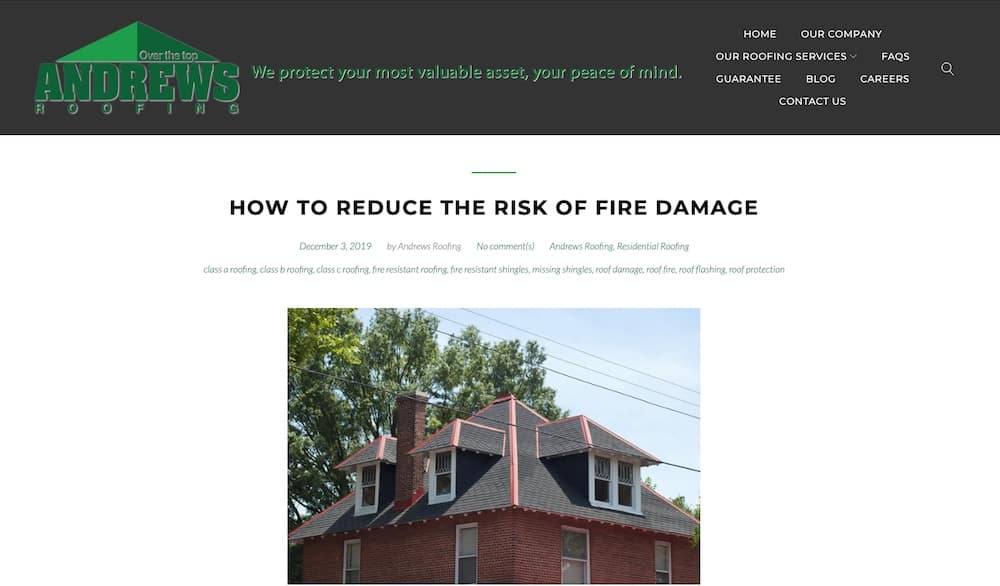
Equipment, tool, and supply reviews
Educating your customers about roofing industry equipment, tools, and products is the perfect way to convert website visitors into paying customers. Visitors to a blog about specific roofing materials, for example, having high commercial intent. What does that mean?
It means they are more likely to purchase a product or service from your business than say a customer is looking at a blog about general roofing maintenance tips.
Here’s an example of this type of roofing blog idea in action from Ironhead Roofing.
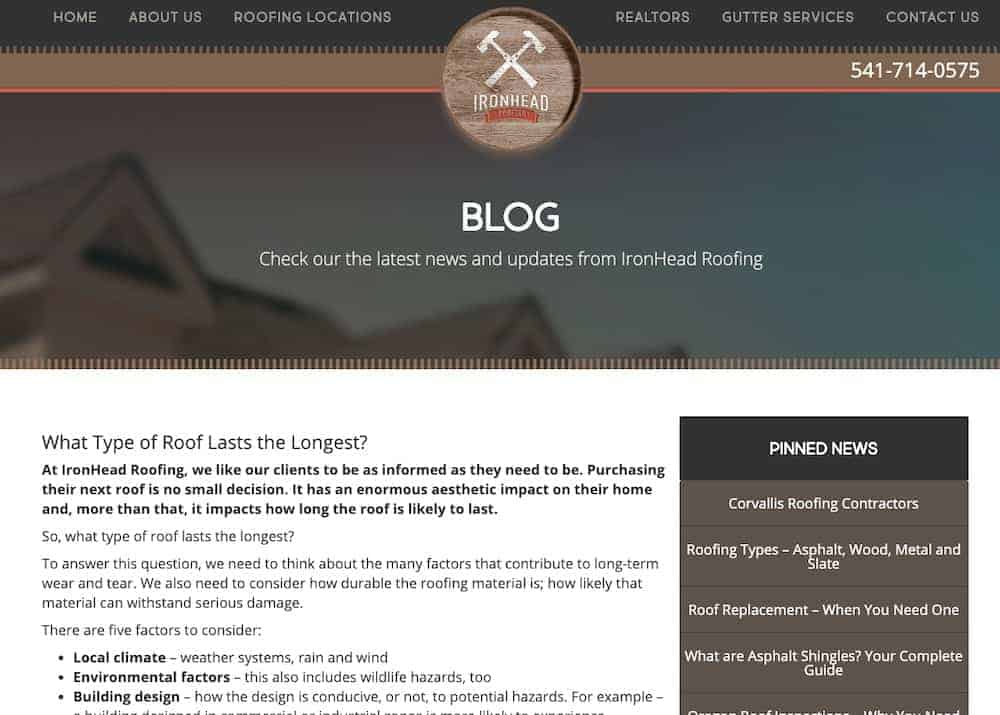
Brainstorming tip: Finding roofing blog ideas using Google Trends
After producing dozens of roofing articles, you might sometimes struggle to find new topics. If that’s the case, we have a few brainstorming tips to keep things fresh.
First, there’s Google Trends.
If you need help finding blog topics, Google Trends is your best friend. It uses data from Google’s search results to show if a keyword is tending and in which region of the country.
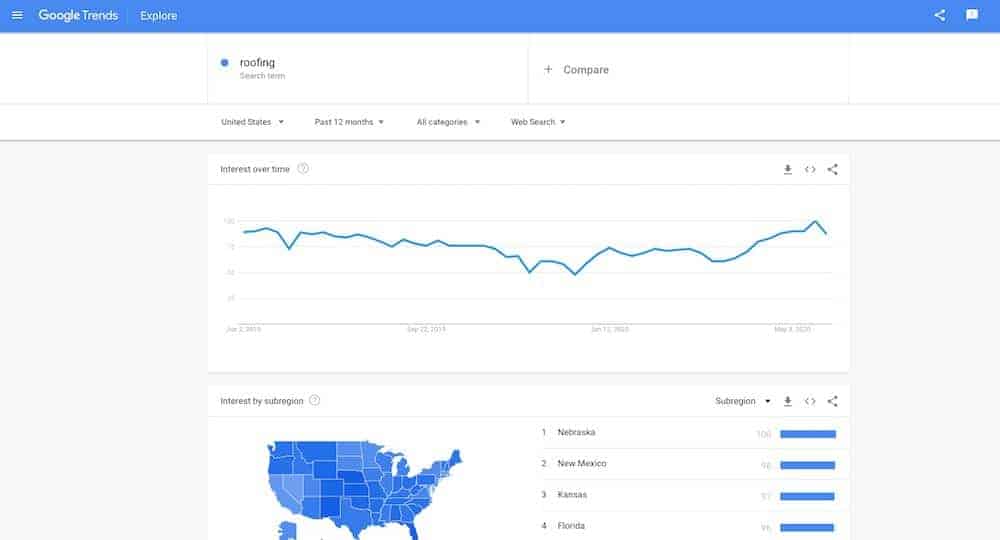
The best feature of Google Trends, however, are the related topics and related queries sections. If you’re looking for blog topics, browsing through trending related queries makes brainstorming much easier.
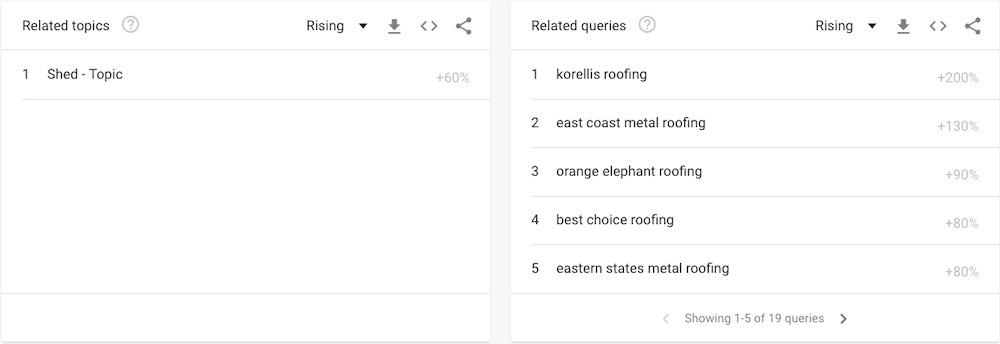
For instance, many different roofing companies are trending in this example. Therefore, creating an article comparing the pros and cons of each competitor (including yourself) would be of interest.
Brainstorming tip: Finding roofing blog ideas using Google Suggest and People Also Ask
Beyond Google Trends, Google provides a couple of other free tools that can help you brainstorm blog topic ideas, Google Suggest and People Also Ask. Google Suggest is the autocomplete feature of any regular search. It uses data on thousands of queries to predict what you might type in. This can be an invaluable tool for finding blog topics that have a chance to gain strong organic traffic.
If you remember the Andrews Roofing article we discussed earlier about frost on a roof, you can see where they might have got their topic idea looking at this Google Suggest of ‘should my roof’.

If Google Suggest doesn’t provide the topic you’re looking for, you can also use the People Also Ask (PAA) section of Google’s results pages to find ideas.
The PAA section shows the most commonly asked questions on Google that relate to your query.
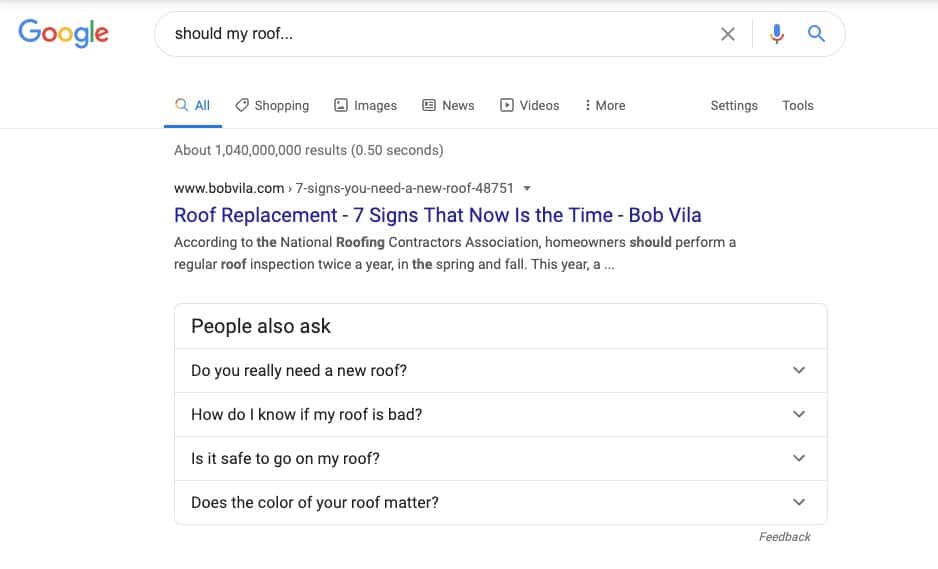
Here’s a great example that shows a lot of people are asking if it’s safe to go on their roof. A question like this could be a great blog post that leads naturally into a call-to-action for the reader to seek roofing repairs for safety.
Best practices for using roofing blogs as a marketing tool
If you’re just starting your roofing blog or you want to revamp your old one, having a few best practices and tips to follow can help attract more customers. So, we put together a list of just a few to get you started:
- Use social media to spread the word about your blog. After publishing each blog, you should be using all your social media channels to promote your new content. If you aren’t sharing it, no one else will.
- Implement keyword research. Blogs need to target specific keywords that potential clients will be interested in to draw in organic traffic. With keyword research and free tools like Google Keyword Planner or Autosuggest, you can target the right keywords and make that happen.
- Use SEO best practices in each blog. Following search engine optimization (SEO) best practices is the only way to get your blog content to attract organic traffic. Taking some time to read up on SEO will make all the difference. Practices like targeting unique keywords within each blog, optimizing title tags and headers, and ensuring mobile optimization are critical to your blog’s success.
- SEO on content marketing doesn’t work overnight. Roofer SEO won’t work within a few days. Creating enough in-depth roofing posts to fill out your blog will take time. Plus, according to Google, it could take anywhere from four months to a year for search engine optimization to take effect, which means organic traffic might be slow at first.
- Format to engage your audience. A block of text will have site visitors click away in seconds. So remember to add in pictures, videos, infographics, charts, links, bolded sections, headings, and anything you can to make your posts aesthetically appealing. The goal is to keep visitors reading your blog, so give them information in the most digestible way possible, but don’t forget search engines either.
- Don’t be afraid to write longer blogs. According to HubSpot, the optimal length for a blog that will generate leads is 2500 words. You may need to spend more time writing blogs than you’d like, but the results from longer blogs are well worth the time spent.
Not enough time to make your own blog? Call in the experts.
You have the tips, you have the topics, now you just have to get writing. Of course, finding the time while running or marketing a business can be difficult.
If you’re looking to start a blog but don’t have the time, call in the experts. We’d be more than happy to get you started on content marketing with a quality blog.
Or check out our article on How to Use Roofing Directories for Local SEO, and get started improving your local customer base today.
Markitors is an internet marketing agency with a focus on SEO. We help small businesses rank higher on Google to draw more leads to websites and increase revenue. Explore what’s in our SEO toolbox: audits and keyword research, digital PR, technical SEO, and local SEO.








